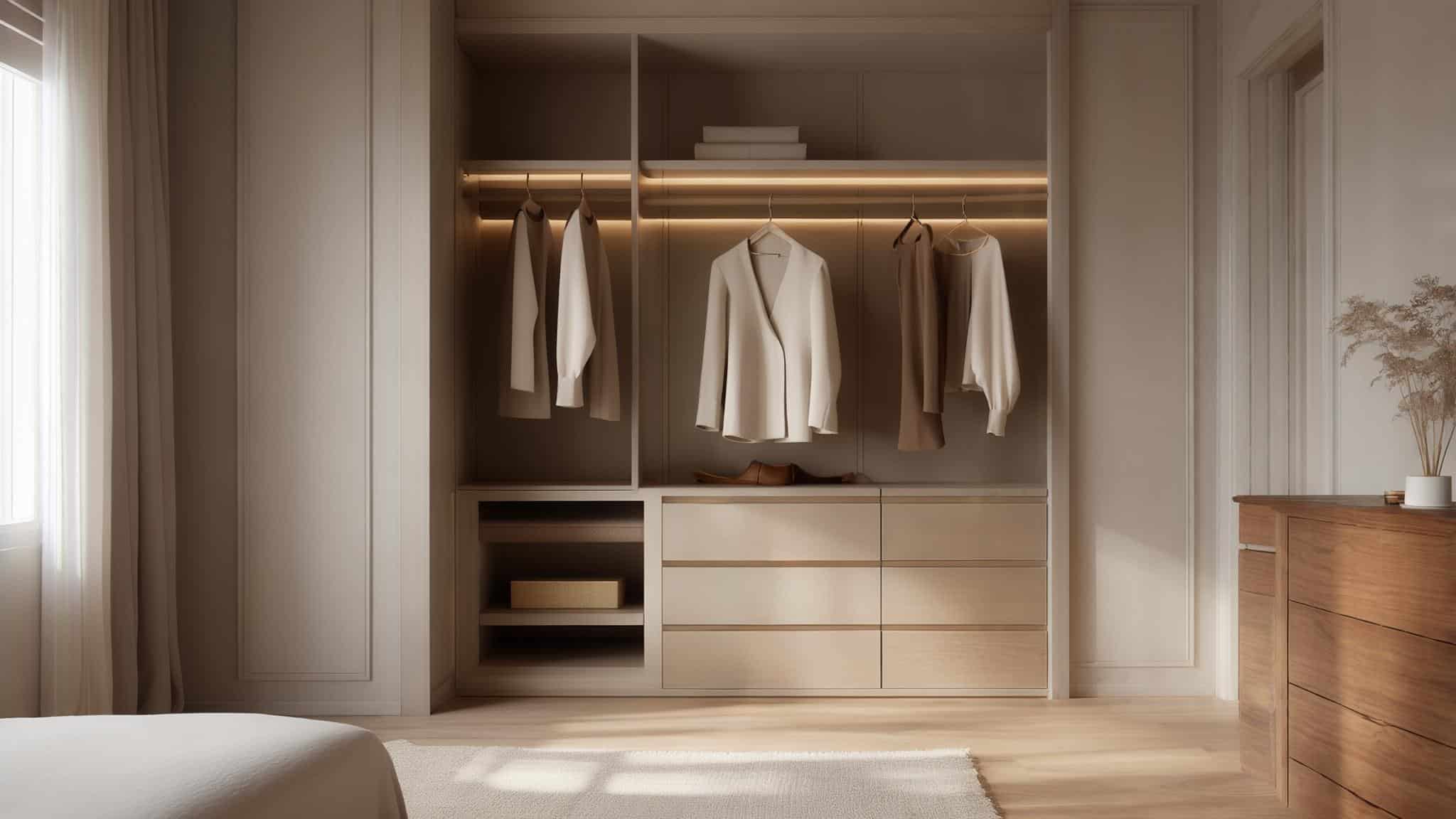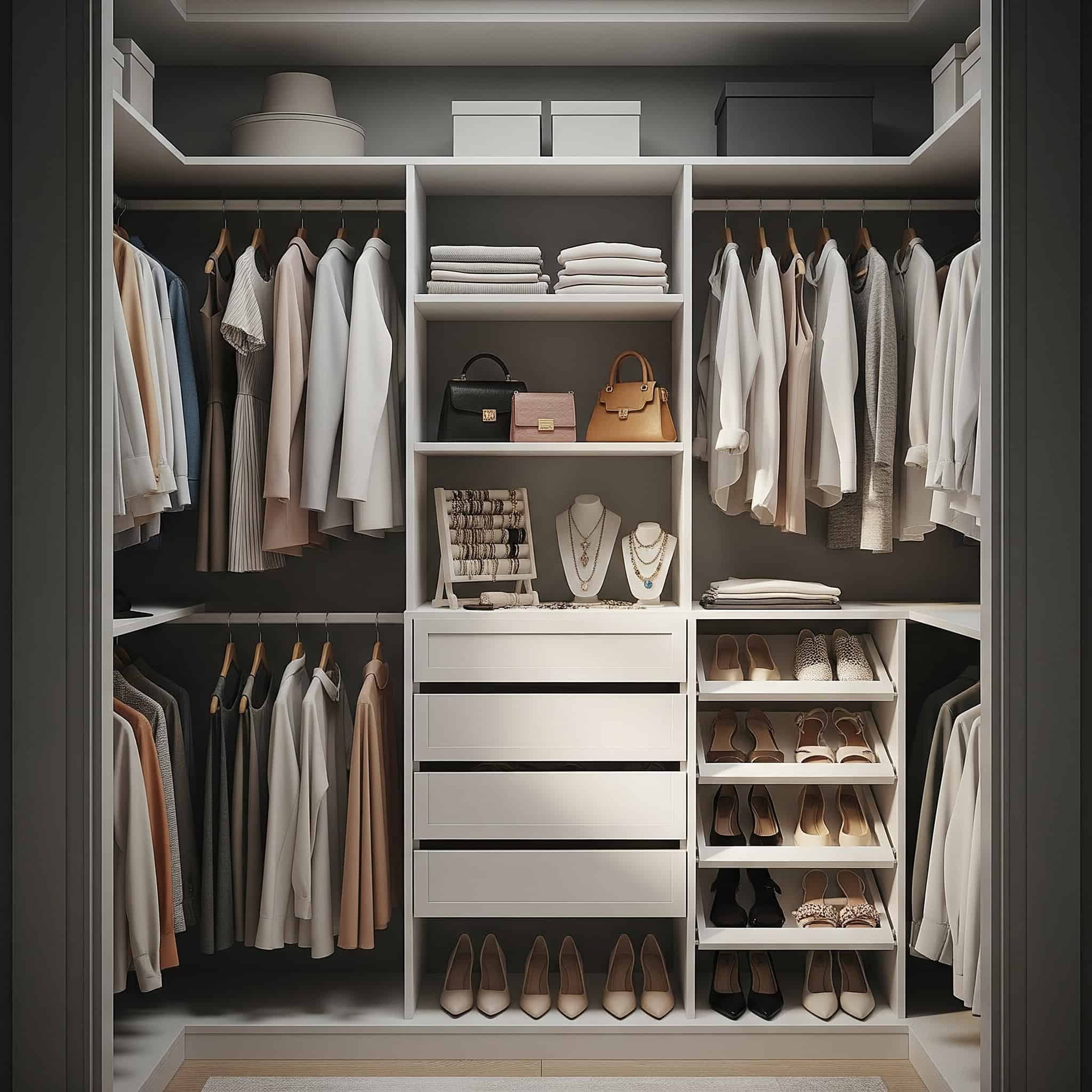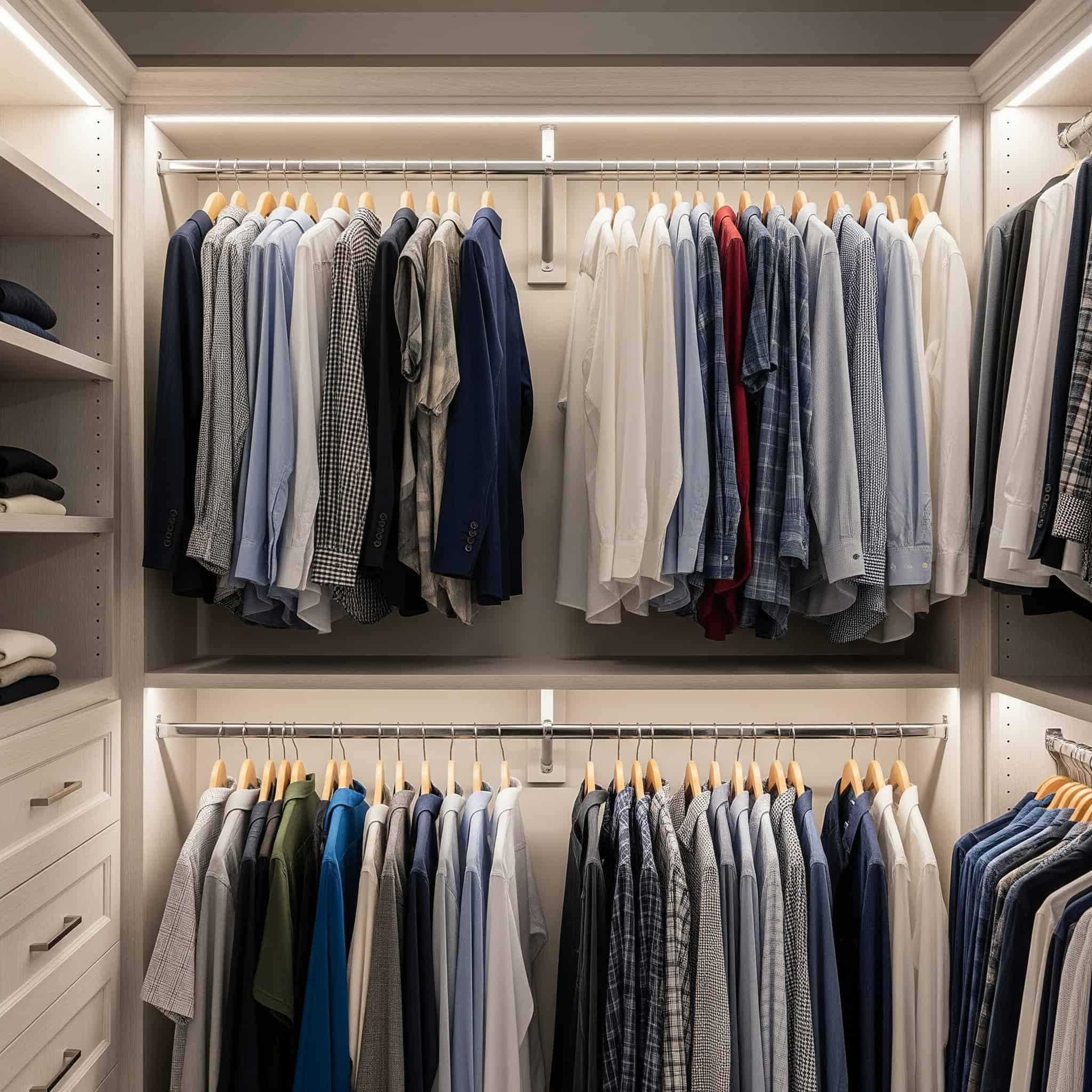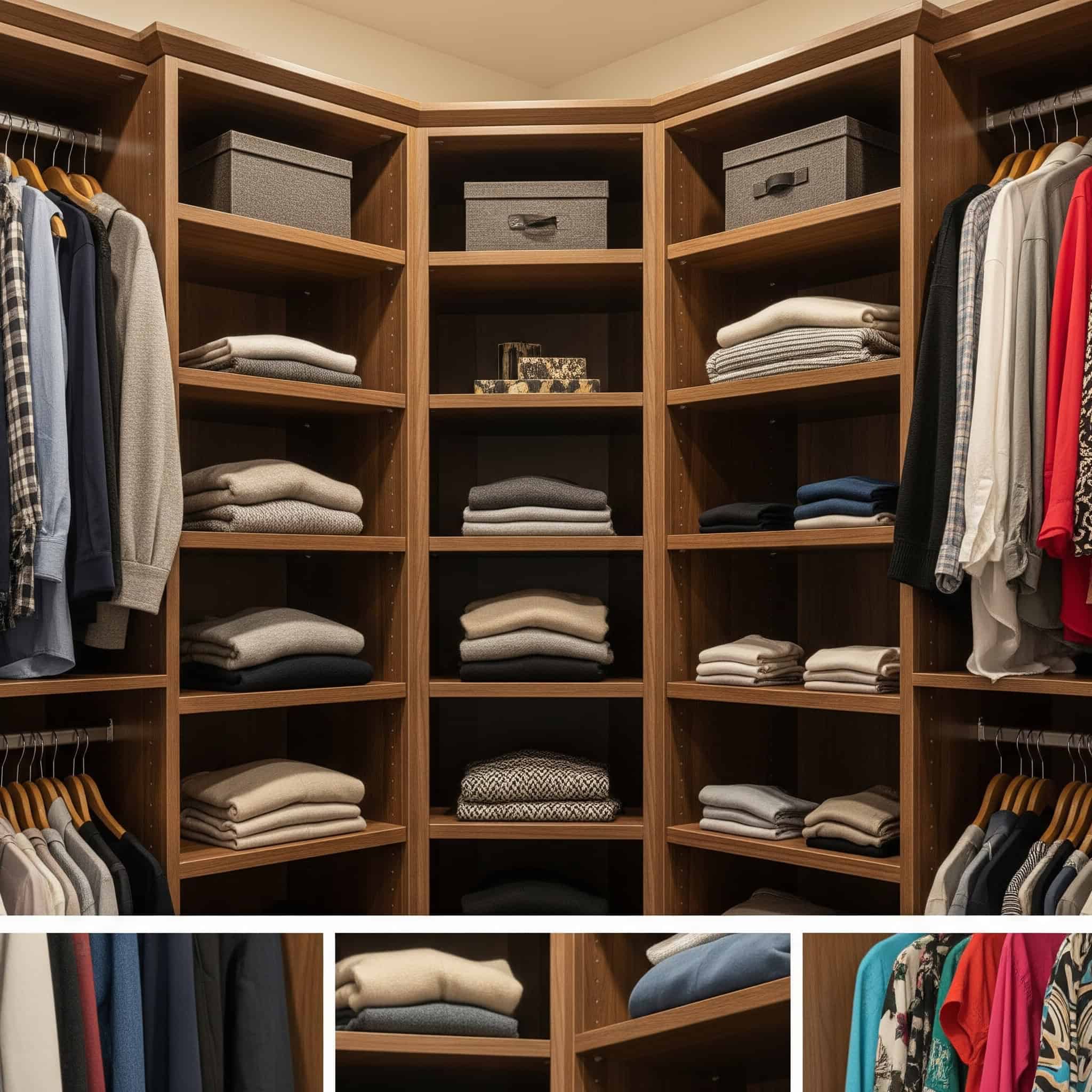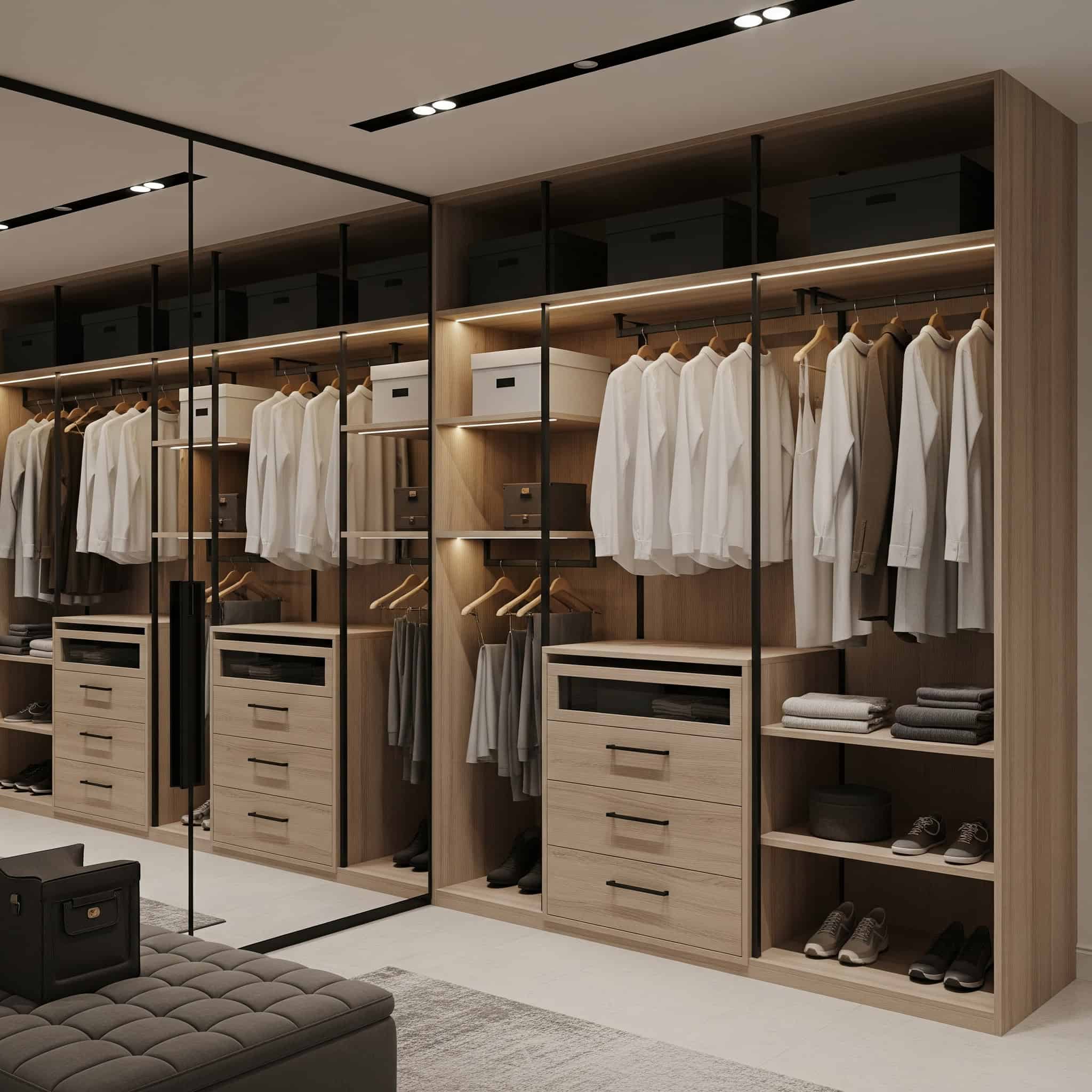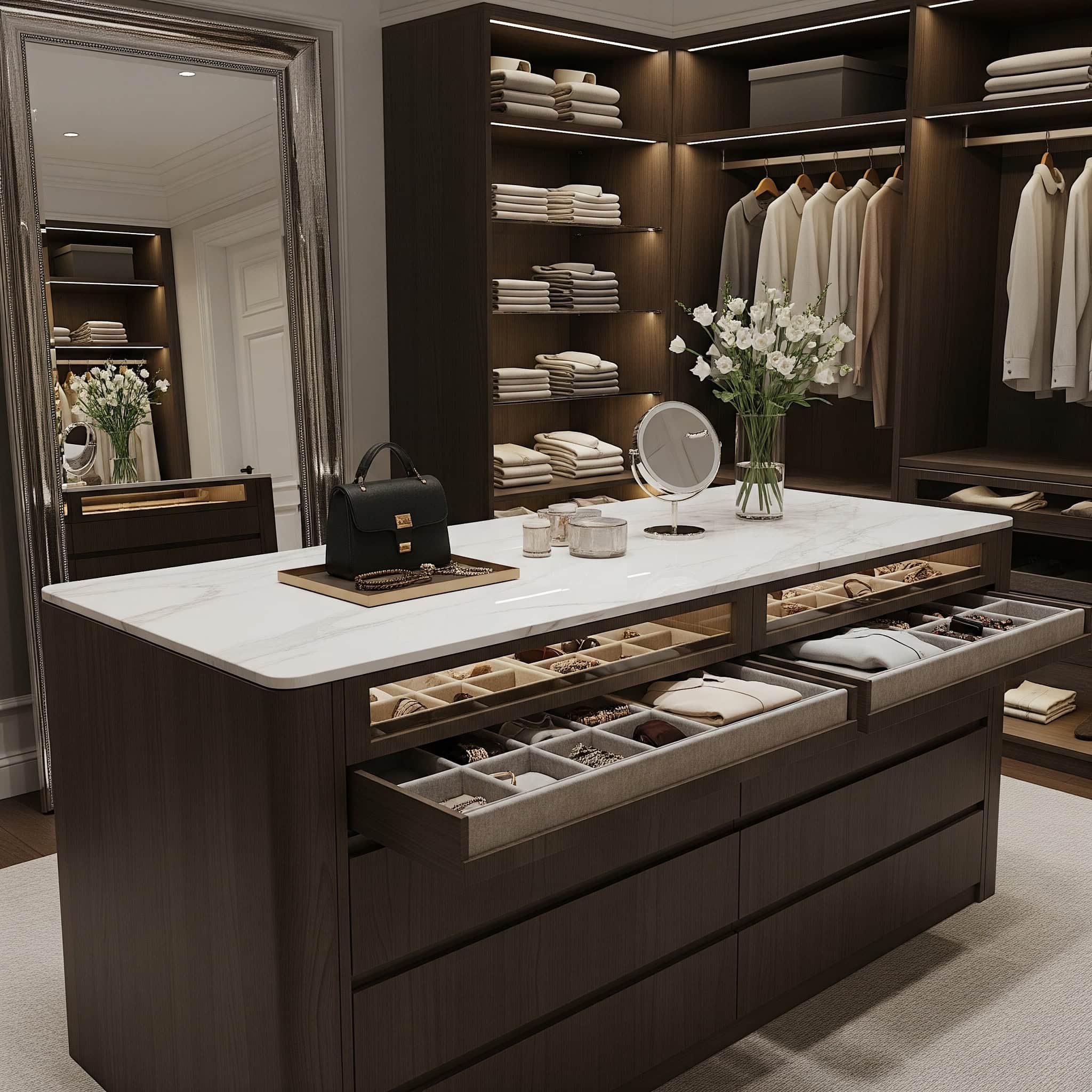25 Game-Changing Bedroom Closet Ideas for 2025: Transform Your Storage Space
Recent surveys show that the average American spends nearly 287 hours per year looking for misplaced items, with clothing being among the most commonly lost possessions. I’ve certainly been there—standing in front of my closet feeling overwhelmed by the chaos. Whether you’re working with a compact reach-in or a spacious walk-in closet, having an organized system can transform your daily routine. This comprehensive guide explores 25 innovative bedroom closet ideas for 2025 that combine functionality, style, and smart technology to maximize your storage potential.
Table of Contents
-
Planning Your Bedroom Closet
-
Space-Maximizing Solutions
-
Smart Technology Integration
-
Aesthetic and Design Innovations
-
Sustainable and Eco-Friendly Options
-
Specialized Organization Systems
-
Closet Transformation Process
Planning Your Bedroom Closet
Before diving into any closet renovation, I’ve learned that proper planning makes all the difference. When I redid my own closet last year, measuring everything twice saved me from some potentially expensive mistakes. Space utilization efficiency increases by up to 30% with proper pre-planning and measurement, especially when you account for door swing clearances and minimum accessibility depths.
You’ll need at least 24 inches of depth for reach-in closets and 36 inches for walk-ins to have a functional space. Budget-wise, be prepared for some investment. Professional closet systems typically cost $1,000-$5,000 for reach-in closets and $3,000-$15,000+ for walk-ins. If you’re going custom, expect to pay $200-$500 per linear foot depending on materials and complexity.
Your lifestyle should directly inform your design choices. I’m a visual person who needs to see all my options, so I opted for open shelving rather than drawers for most items. Think about your daily routines and storage habits when planning your layout.
|
Closet Type |
Minimum Depth |
Typical Cost Range |
Space Efficiency Tips |
|---|---|---|---|
|
Reach-in |
24″ minimum |
$1,000-$5,000 |
Use door-mounted organizers; maximize vertical space |
|
Walk-in Small |
36″ minimum |
$3,000-$8,000 |
Double-hang rods; utilize corners with specialized shelving |
|
Walk-in Medium |
48″ minimum |
$5,000-$12,000 |
Add central island if space permits; floor-to-ceiling storage |
|
Walk-in Large |
60″+ minimum |
$10,000-$15,000+ |
Incorporate seating; dedicated zones for different clothing types |
Space-Maximizing Solutions
1. Double-Hang Rod Systems
Double-hang rod systems instantly doubled my hanging capacity when I installed them last spring. By positioning two parallel rods—one above the other—I created separate zones for shirts, blouses, and folded pants. This simple change works wonders in closets with limited width but good height.
Standard hanging heights are 42″ for the top rod and 84″ for the bottom rod, with 40″ of vertical clearance between them. This spacing accommodates most hanging garments while maximizing efficiency. Make sure your installation is solid—these systems typically support 30-35 pounds per linear foot when properly installed into studs. I recommend using 16-gauge steel or stronger for long-term durability.
The beauty of this solution is its simplicity. It’s budget-friendly, requires minimal installation expertise, and dramatically increases storage capacity without structural modifications.
2. Corner Shelving Utilization
Those awkward corners in walk-in closets used to drive me crazy until I discovered specialized corner shelving. L-shaped or curved shelving units transform these dead zones into valuable storage space for folded items, accessories, or display pieces.
Corner shelving increases storage capacity by 15-20% in typical walk-in closets by utilizing approximately 4-9 square feet of otherwise wasted space in each corner. When shopping for these units, pay attention to the angles. L-shaped corner units require precise 90° angle measurements, while curved corner shelving accommodates irregular corners between 85-95° with custom radius options ranging from 12-24 inches.
In a recent closet renovation for a client with a 10′ x 12′ walk-in closet, we discovered that the four corner areas represented nearly 20 square feet of wasted space. By installing custom L-shaped corner shelving units with graduated depths (12″ at the sides tapering to 14″ at the corner point), we created dedicated storage for folded sweaters and handbags. This single modification added enough storage for 36 sweaters and 12 handbags without reducing the closet’s central walking area, effectively increasing the client’s usable storage space by 18% with minimal investment.
3. Floor-to-Ceiling Customization
I’m always amazed by how much space exists above standard closet installations. Floor-to-ceiling storage systems eliminate this wasted area by extending the full height of your closet, incorporating a mix of hanging rods, shelving, and drawers.
Floor-to-ceiling systems increase storage capacity by 25-40% compared to standard closet installations that typically stop at 84″ height. They utilize the often-wasted 12-36″ of vertical space below the ceiling. Professional installation requires precise leveling with a maximum tolerance of 1/8″ deviation to ensure proper door and drawer function. You’ll also need weight-bearing capacity calculations for upper sections, which are typically rated for 75-100 lbs per linear foot.
While requiring a higher initial investment and professional installation, the dramatic increase in storage capacity makes this approach worthwhile. For accessing upper areas, I recommend incorporating a sliding ladder or step stool to ensure you can comfortably reach items stored in higher zones.
4. Pull-Out Accessory Organizers
Small accessories used to disappear in my drawers until I installed pull-out accessory organizers. These slim, specialized drawers or racks slide out smoothly to display ties, belts, scarves, jewelry, and other accessories in an organized, visible arrangement.
Pull-out systems operate on ball-bearing slides rated for 75-100 pounds of weight capacity with 75% extension for standard models and 100% extension for full-access models. Specialized accessory organizers reduce search time by up to 70% through categorized storage. The optimal dimensions are 3-5″ width for tie racks, 6-8″ for belt organizers, and 12-24″ for multi-purpose accessory drawers.
Each item gets its designated spot, making it easy to find what you need while preventing damage from improper storage. These space-efficient solutions fit into narrow gaps between larger closet components, turning previously unusable spaces into functional storage.
5. Hidden Storage Innovations
The most underrated storage spaces are often hiding in plain sight. Hidden storage solutions create additional space in unexpected places throughout your closet. I’ve found storage ottomans that provide seating and concealed storage, under-shelf baskets that utilize the space between shelves, and behind-door organizers that transform empty door surfaces into functional storage zones.
Hidden storage solutions can increase total storage capacity by 15-25% in standard closets by utilizing negative space like the 4-6″ clearance under hanging clothes or the 18-24″ of vertical door surface area. Weight capacity considerations are crucial for suspended systems, with door-mounted organizers typically limited to 20-35 pounds total weight to prevent hardware strain and door misalignment.
These budget-friendly options work particularly well in smaller closets where every inch counts. They’re perfect for storing seasonal or less frequently used items that you want to keep accessible but out of sight.
Smart Technology Integration
6. Motion-Sensor Lighting
I’ll never go back to fumbling for light switches in dark closets after installing motion-sensor lighting. These systems automatically illuminate when you enter the space, ranging from simple battery-operated stick-on lights to sophisticated hardwired installations.
Motion detection ranges typically span 8-15 feet with 120° detection angles. Advanced systems offer adjustable sensitivity and timeout settings (30 seconds to 10 minutes). Energy consumption for LED motion-sensor systems averages 5-15 watts during operation compared to 60-100 watts for traditional closet lighting, resulting in 70-90% energy savings with an average ROI period of 14-18 months.
Beyond convenience, motion-sensor lighting offers significant energy efficiency by ensuring lights only operate when needed. The technology has become more affordable and user-friendly, making it accessible for most closet renovations regardless of budget constraints.
7. Digital Inventory Management
“Do I already own a black turtleneck?” That question used to send me digging through my entire closet. Digital inventory systems have changed that by helping me catalog and track clothing items. Using smartphone apps and digital tools, you can photograph garments, add descriptions, track wear frequency, and even plan outfits virtually.
Digital inventory applications utilize machine learning algorithms to categorize clothing items with 85-95% accuracy. Advanced systems offer color matching and style pairing suggestions based on established fashion principles. Cloud-based wardrobe management systems typically require 2-5GB of storage for a comprehensive wardrobe catalog of 250-300 items with high-resolution images, with synchronization capabilities across multiple devices.
While requiring an initial time investment to set up, these systems eliminate the frustration of forgetting what you own or buying duplicate items. They’re particularly valuable for those with extensive wardrobes or who travel frequently and need to plan outfits in advance.
|
Digital Wardrobe App |
Key Features |
Price Range |
Best For |
|---|---|---|---|
|
Stylebook |
Virtual outfit planning, clothing stats, packing lists |
$3.99 one-time |
Fashion enthusiasts with extensive wardrobes |
|
Smart Closet |
Wear tracking, outfit suggestions, calendar integration |
Free (basic), $4.99/month (premium) |
Daily outfit planners and minimalists |
|
Whering |
AI-powered outfit suggestions, sustainability tracking |
Free (basic), $7.99/month (premium) |
Eco-conscious users focused on wardrobe sustainability |
|
YourCloset |
Multiple virtual closets, occasion tagging, style stats |
Free with in-app purchases |
Seasonal wardrobe organizers and frequent travelers |
|
Acloset |
Color analysis, style coordination, shopping integration |
Free (basic), $3.99/month (premium) |
Color-focused dressers and shopping enthusiasts |
8. Motorized Rotating Systems
The first time I saw a motorized rotating closet system, I felt like I was in a sci-fi movie. These carousel-style systems bring your clothes to you rather than requiring you to search through crowded racks. They rotate horizontally or vertically at the touch of a button, displaying your garments sequentially for easy selection.
Motorized systems typically operate on 110V standard electrical circuits drawing 2-4 amps during operation, with weight capacities ranging from 600-1,200 pounds depending on the model and mounting specifications. Rotation mechanisms utilize gear-driven motors with torque ratings of 50-100 in-lbs, achieving full rotation cycles in 15-30 seconds with noise levels below 45 decibels for premium models.
While representing a significant investment, these systems maximize space efficiency in smaller closets by storing more items in a compact footprint. They’re particularly valuable for those with mobility limitations or in situations where closet depth exceeds comfortable reach distance.
9. Climate Control Solutions
My vintage leather jacket was showing signs of damage until I installed climate control in my closet. These solutions protect valuable garments from environmental damage by regulating humidity and temperature. Systems range from simple dehumidifiers to comprehensive climate management technology that maintains optimal conditions year-round.
Optimal closet climate conditions maintain 45-55% relative humidity and temperatures between 65-75°F to prevent mold growth, fabric deterioration, and color fading in textiles. Advanced systems incorporate hygrometers accurate to ±2% RH and thermostats with ±1°F precision, with programmable controls that adjust based on seasonal variations and can be monitored remotely via smartphone applications.
They’re particularly important for preserving high-end clothing, leather goods, and delicate fabrics that can be damaged by moisture, heat, or dryness. While representing an additional cost, these systems protect your wardrobe investment and extend the life of your clothing.
10. Smart Mirrors with Virtual Try-On
Smart mirrors with virtual try-on capabilities feel like something from the future, but they’re available now. These interactive mirrors allow you to see how different clothing combinations look without physically changing outfits. Using cameras and augmented reality, they superimpose garments onto your reflection, enabling quick outfit experimentation and planning.
Smart mirror systems utilize high-definition displays (minimum 1080p resolution) with anti-glare coating and integrated cameras capturing at 60fps for realistic rendering of virtual garments with minimal lag (under 100ms). Augmented reality software employs body mapping algorithms with 32-48 tracking points to accurately overlay virtual clothing with proper draping physics, requiring 8-16GB RAM and dedicated graphics processing for smooth operation.
While a luxury addition with a higher price point, these mirrors save significant time in daily outfit selection and help you discover new combinations from clothes you already own.
Aesthetic and Design Innovations
11. Statement Lighting Fixtures
Lighting transformed my closet from a functional box to a space I actually enjoy spending time in. Statement lighting fixtures elevate your closet from a purely functional space to a design feature in your bedroom. Options range from elegant chandeliers and pendant lights to modern track lighting and decorative sconces.
Optimal closet lighting requires 10-20 lumens per square foot for ambient lighting and 20-50 lumens per square foot for task-specific areas, with color temperatures between 2700K (warm) and 4000K (cool) depending on color rendering preferences. Fixture placement should follow the 30-30-30 rule: ceiling fixtures every 30 inches, 30 inches from walls, with bulbs 30 inches from shelving to prevent heat damage to clothing while minimizing shadows.
These fixtures serve dual purposes: providing essential illumination for finding and assessing clothing while adding personality and style to your closet space. When selecting statement lighting, consider both ambient illumination for the overall space and task lighting for specific areas like dressing zones or jewelry storage.12. Custom Color Schemes
White closets are standard, but why be standard? Custom color schemes transform your closet from a neutral storage space into a personalized extension of your bedroom design. Whether through painted walls, colorful shelving, or patterned wallpaper, introducing intentional color creates a more inviting and cohesive environment.
Semi-gloss or satin finish paints with VOC levels below 50 g/L are optimal for closet interiors, providing stain resistance and cleanability while minimizing off-gassing that could affect clothing. Color psychology research indicates that blue tones promote calmness and organization, while warmer tones like soft yellows enhance visibility of clothing items by complementing most fabric colors with minimal color distortion.
A client with a medium-sized walk-in closet wanted to create distinct zones for different clothing categories while maintaining a cohesive look. We implemented a color-blocking strategy using three complementary colors: a soft sage green for the everyday workwear section, a muted navy blue for formal attire, and a warm taupe for casual weekend clothing. Each zone received its color on the back wall only, with white shelving and hardware throughout for consistency. The color-coding not only created visual interest but also served as an intuitive organizational system—the client reported that the color zones reduced her morning decision time by nearly 10 minutes as she could instantly navigate to the appropriate section for her day’s activities.
Light colors generally make small closets feel more spacious, while bold accents can define different functional zones. This relatively low-cost customization option allows you to refresh your closet’s appearance without structural changes and can be updated easily as your preferences evolve.
13. Glass and Mirrored Elements
I added glass cabinet doors to my closet last year, and they’ve been game-changers for both function and style. Glass and mirrored elements bring sophistication to closet design while serving practical purposes. Glass cabinet doors protect clothing from dust while allowing you to see contents at a glance. Mirrored surfaces reflect light, making the space feel larger and brighter while providing functionality for outfit assessment.
Tempered glass doors (minimum 3/16″ thickness) offer 4-5 times the impact resistance of standard glass, with frameless options requiring specialized hinges rated for 8-12 pounds per door. Mirrored surfaces increase perceived space by approximately 30% through light reflection, with silvered mirrors offering 85-95% reflectivity compared to economy mirrors at 70-80%, significantly affecting brightness and color accuracy.
These materials create a high-end, boutique-like atmosphere that elevates your daily dressing experience. While requiring more frequent cleaning than solid surfaces, the visual expansion and enhanced functionality they provide make them worth considering for most closet designs.
14. Boutique-Style Islands
Walking around my closet island makes me feel like I’m shopping in a high-end store every morning. Boutique-style islands bring the luxury of retail spaces into your personal closet. These freestanding units typically feature drawers for storage, a countertop surface for folding or outfit planning, and sometimes additional features like jewelry trays or seating.
Optimal island dimensions maintain 36-42″ clearance on all sides for comfortable movement, with counter heights standardized at 36″ and drawer depths of 14-18″ to maximize storage while maintaining accessibility. Structural support requirements include minimum 3/4″ plywood construction for drawer boxes with undermount soft-close slides rated for 75-100 pounds, and countertops engineered to support 15-20 pounds per square foot for normal use.
Islands create a focal point in larger walk-in closets while providing valuable additional storage and workspace. They’re particularly useful for organizing accessories, folded garments, or items that don’t hang well. While requiring substantial floor space, islands transform closets into true dressing rooms rather than mere storage areas.
15. Integrated Seating Areas
Adding a small bench to my closet was one of my best decisions—no more hopping on one foot while trying to put on shoes! Integrated seating areas add both comfort and functionality to your closet space. Whether a built-in bench, upholstered ottoman, or small chair, seating provides a place to put on shoes, plan outfits, or simply rest during extended dressing sessions.
Ergonomic seating height ranges from 17-19″ for optimal comfort during shoe changing, with weight capacity ratings of 250-300 pounds recommended for daily use durability. Hinged bench storage requires heavy-duty lid supports rated for 80-120 inch-pounds of torque to prevent slamming, with ventilated storage compartments recommended for items like shoes to prevent odor accumulation.
Many seating options incorporate additional storage underneath, maximizing functionality in a single element. This feature transforms your closet from a purely utilitarian space into a comfortable dressing room where you can take your time with outfit selection and preparation.
Sustainable and Eco-Friendly Options
16. Reclaimed Wood Applications
The shelving in my closet has a story to tell—it was once part of a 100-year-old barn. Reclaimed wood brings character, history, and environmental responsibility to your closet design. Shelving, drawer fronts, and decorative elements crafted from repurposed wood reduce demand for new timber while introducing unique textures and patinas impossible to replicate with new materials.
Reclaimed wood typically exhibits 40-60% greater dimensional stability than newly harvested lumber due to decades of natural curing, resulting in reduced warping and splitting in variable humidity environments like closets. Proper preparation of reclaimed wood requires kiln drying to moisture content of 6-8% and treatment with borate-based preservatives that offer pest resistance without harmful VOCs, ensuring long-term durability without chemical off-gassing.
Each piece tells a story through its distinctive grain patterns, color variations, and natural wear. While potentially more expensive than standard materials, reclaimed wood offers exceptional durability and a distinctive aesthetic that improves with age, making it both a sustainable choice and a design statement.
17. Modular Adaptable Systems
I’ve changed my closet configuration three times as my needs have evolved, all without replacing the entire system. Modular adaptable systems offer sustainability through longevity and flexibility. These customizable components can be reconfigured as your storage needs evolve, eliminating the waste associated with complete closet replacements.
Modular systems utilize standardized connection points with 32mm system holes spaced at precise intervals, allowing components to be reconfigured with positional accuracy of ±0.5mm for proper alignment and function. High-quality modular systems employ recyclable materials like aluminum extrusions (100% recyclable) and formaldehyde-free composite boards that meet CARB Phase 2 compliance standards for indoor air quality with emissions below 0.05 ppm.
When you need to adjust your storage configuration, you simply rearrange or add components rather than starting over. This approach provides both environmental and financial benefits over time. Look for systems with recyclable materials and components that can be easily disassembled and repurposed to maximize the sustainability benefits.
|
Sustainable Closet Material |
Environmental Benefit |
Durability Rating |
Relative Cost |
|---|---|---|---|
|
Reclaimed Wood |
Prevents deforestation; reduces landfill waste |
High (40-50+ years) |
$$$ |
|
Bamboo |
Renewable resource (grows 3-5 years); biodegradable |
Medium-High (20-30 years) |
$$ |
|
Recycled Aluminum |
95% less energy than new aluminum; infinitely recyclable |
Very High (50+ years) |
$$$ |
|
FSC-Certified Wood |
Sustainably harvested; chain of custody verified |
Medium-High (25-40 years) |
$$ |
|
Cork |
Harvested without killing trees; biodegradable |
Medium (15-25 years) |
$$ |
|
Recycled Plastic |
Diverts plastic from landfills and oceans |
Medium (15-20 years) |
$ |
|
Natural Fiber Composites |
Biodegradable; uses agricultural byproducts |
Medium (15-25 years) |
$$ |
18. Natural Fiber Storage
The seagrass baskets in my closet add texture while being kind to the planet. Natural fiber storage containers bring organic textures and sustainable materials into your closet organization system. Baskets and bins crafted from bamboo, seagrass, water hyacinth, or other renewable resources provide attractive alternatives to plastic storage options.
Natural fiber containers provide 200-300% better air circulation than plastic alternatives, with moisture regulation properties that maintain 3-5% lower humidity levels for stored textiles. Bamboo, the most durable natural fiber option, offers tensile strength comparable to steel (28,000 psi) while growing to harvest maturity in 3-5 years compared to 25-50 years for hardwoods used in conventional storage products.
These materials allow airflow to clothes, reducing moisture buildup and odors. While they may not offer the same durability as synthetic options in humid environments, their biodegradability and renewable sourcing make them an environmentally responsible choice that adds warmth and texture to your closet design.
19. Energy-Efficient Lighting
Switching to LED lighting in my closet cut my energy use dramatically while providing better illumination. Energy-efficient lighting reduces your closet’s environmental impact while providing superior illumination. LED fixtures use significantly less electricity than traditional incandescent or fluorescent options while lasting much longer, reducing both energy consumption and waste from bulb replacements.
LED closet lighting systems operate at 80-90% efficiency (compared to 10-15% for incandescent) with lifespans of 25,000-50,000 hours, reducing replacement frequency by 25x while consuming 75-85% less energy. Color rendering index (CRI) ratings of 90+ are optimal for closet applications to accurately represent clothing colors, with tunable systems offering adjustable color temperatures from 2700K-5000K to accommodate different visual preferences and time-of-day usage.
Strategic placement with timers or automatic shut-off features further minimizes unnecessary energy use. Where possible, incorporating natural light through small windows or light tubes not only saves energy but also provides the most accurate color rendering for clothing selection.
20. Air-Purifying Elements
The small snake plant in the corner of my closet isn’t just decorative—it’s actively improving the air quality. Air-purifying elements maintain freshness in enclosed closet spaces naturally. Small potted plants like snake plants or pothos improve air quality by filtering toxins and releasing oxygen. For closets without natural light, activated charcoal bags, bamboo charcoal, or cedar blocks provide chemical-free odor absorption and humidity regulation.
Activated charcoal absorbs odors and excess humidity through microporous structure with surface areas of 300-2,000 m²/g, capturing molecules as small as 0.5 microns without releasing secondary compounds. NASA clean air studies demonstrate that certain houseplants remove 87-94% of volatile organic compounds (VOCs) from enclosed spaces within 24 hours, with snake plants specifically removing formaldehyde and benzene commonly found in clothing manufacturing processes.
These natural solutions protect your clothing from musty smells while avoiding the chemicals found in many commercial fresheners. They require minimal maintenance while providing ongoing benefits to both your wardrobe and the environment.
Specialized Organization Systems
21. Seasonal Rotation Solutions
Living in a four-season climate with limited closet space forced me to get serious about seasonal rotation. Seasonal rotation solutions help manage clothing that’s only needed part of the year, freeing up prime closet real estate for current-season items. Vacuum-sealed bags dramatically reduce the volume of bulky winter coats or bedding, while specialized containers protect delicate fabrics from dust and pests during storage.
Vacuum compression technology reduces garment volume by 60-80% by removing air through one-way valves, with higher-quality bags utilizing 100-micron thick polyethylene with UV inhibitors to prevent plastic degradation and yellowing of white fabrics. Optimal seasonal storage requires maintaining stable temperatures between 50-75°F with humidity levels below 65% to prevent mold growth, with cedar or lavender inserts providing natural moth deterrence without naphthalene chemicals found in mothballs.
A client with a 300-square-foot primary bedroom but only a standard 6′ wide reach-in closet implemented a comprehensive seasonal rotation system that transformed her storage capabilities. She divided her wardrobe into three distinct categories: current season (accessible in the main closet), transitional items (stored in under-bed containers), and off-season (stored in the guest room closet in vacuum-sealed bags). Using a digital inventory system with QR code labels, she could quickly locate any stored item when needed. The rotation system operated on a quarterly schedule with two weekend afternoons dedicated to the swap process. This systematic approach allowed her to effectively manage a wardrobe three times larger than her visible closet space would suggest, while keeping seasonal items properly preserved and easily retrievable when needed.
For a complete home organization system that extends beyond your closet, consider implementing decluttering strategies throughout your home. Our comprehensive decluttering guide offers practical tips to maintain organization in every room.
22. Shoe Display Systems
My shoe collection went from a jumbled pile to an organized display that makes me smile every morning. Shoe display systems transform footwear from a storage challenge into a design feature. Options range from angled shelving that showcases your collection to clear boxes that protect shoes while keeping them visible.
Optimal shoe shelf angles range from 15-20° for visibility without causing footwear to slide, with shelf depths of 10-12″ for women’s shoes and 12-14″ for men’s shoes to accommodate full heel-to-toe dimensions. Archival-quality shoe storage boxes utilize acid-free materials with pH levels between 7.5-8.5 and include silica gel packets (10-15g per box) to maintain optimal humidity levels between 35-45% for leather preservation.
These systems prevent damage from stacking or cramming shoes into standard shelves while making selection easier. For collectors, illuminated displays highlight special pieces, while space-saving vertical organizers work well for everyday footwear. Proper shoe storage extends the life of your footwear by maintaining shape and preventing dust accumulation.
23. Jewelry Organization Centers
I used to spend frustrating minutes untangling necklaces until I installed a proper jewelry organization center. These specialized storage systems are designed for different types of accessories, including velvet-lined trays for rings, vertical hooks for necklaces, and compartmentalized sections for earrings and bracelets.
Anti-tarnish technology in premium jewelry organizers incorporates 3M anti-tarnish strips containing activated carbon and silver-specific neutralizers that absorb sulfur compounds and prevent oxidation for up to 6-12 months before replacement. Optimal drawer insert dimensions follow the 60/40 rule: allocating 60% of space to frequently worn pieces in easily accessible configurations and 40% to special occasion pieces, with compartment sizing standardized at 2″ for rings, 3″ for earrings, and 12-18″ for necklaces.
Proper jewelry storage prevents tangling, scratching, and loss of small items while making your collection easily visible for selection. These centers can be incorporated into drawer inserts, wall-mounted displays, or dedicated cabinets depending on your space and collection size. For valuable pieces, look for options with secure closures or built-in locks.
24. Laundry Management Integration
The built-in hamper system in my closet has eliminated the eyesore of a standalone hamper in my bedroom. Laundry management integration streamlines your clothing care routine by incorporating sorting and collection directly into your closet system. Built-in hampers with dividers allow immediate sorting of lights, darks, and delicates as items come off.
Ventilated hamper systems increase airflow by 200-300% compared to solid containers, reducing bacterial growth and odor development in soiled clothing through perforations comprising 15-20% of the surface area. Pull-out hamper mechanisms require heavy-duty slides rated for dynamic loads of 75-100 pounds with soft-close dampeners that reduce impact force by 80-90% to prevent hardware fatigue and frame damage over time.
Pull-out or tilt-out hamper designs save floor space while keeping dirty laundry organized and out of sight. Some systems include removable bags for easy transport to laundry facilities. This integration eliminates the need for separate hampers in your bedroom, creating a more streamlined appearance while improving your laundry workflow.
25. Valet Rods and Dressing Areas
The pull-out valet rod I installed has become one of my most-used closet features. Valet rods and designated dressing areas bring hotel-like convenience to your daily routine. Pull-out rods provide temporary hanging space for outfit planning, steaming, or airing out clothes. A dedicated dressing zone with proper lighting, a full-length mirror, and adequate clearance transforms the act of getting dressed from a hurried task to an enjoyable experience.
Valet rods require mounting hardware rated for 25-35 pounds of static load with extension mechanisms that maintain stability at full extension (typically 12-16 inches) without deflection exceeding 1/4 inch. Optimal dressing area dimensions follow the 5×5 rule: minimum 5 square feet of standing space with lighting positioned 5 feet from mirrors to eliminate shadows, ideally with three-way mirrors providing 45° angle views for complete outfit assessment.
These thoughtful additions enhance your closet’s functionality by supporting your complete dressing process rather than merely storing clothes. Strategic placement aligned with your daily routine maximizes their practical benefits.
Closet Transformation Process
The journey to your ideal closet begins with clearing out what no longer serves you. Before implementing any new organization systems, you’ll need to remove unwanted items and outdated storage components. This crucial decluttering phase creates a clean slate for your closet remodel.
Professional decluttering typically removes 30-50% of existing closet contents based on the 80/20 principle (most people regularly wear only 20% of their clothing), creating essential space for optimized organization systems. The average bedroom closet renovation generates 150-300 pounds of disposal material including old shelving, clothing, and packaging, with eco-conscious removal services diverting 60-80% from landfills through recycling and donation channels.
When preparing for a major closet transformation, consider how your organization efforts can extend beyond just clothing. Many homeowners find that a comprehensive office clean out in conjunction with bedroom organization creates a more harmonious living and working environment.
How Jiffy Junk Can Help With Your Closet Transformation
Jiffy Junk’s white-glove removal service can play a crucial role in your closet transformation journey. Their professional team handles the heavy lifting of removing old shelving, unwanted clothing, and outdated storage systems, allowing you to focus on planning your new dream closet.
Their removal process includes disassembly of built-in components using specialized tools that minimize wall and floor damage, with technicians trained in non-destructive removal techniques. Their sorting protocols separate materials into 5-7 distinct waste streams including metal recycling, wood recycling, textile donation, and e-waste processing, achieving diversion rates 30-40% higher than standard junk removal services.
If your closet renovation includes removing old furniture or built-ins, you’ll need reliable disposal options. Our furniture removal guide provides essential information about eco-friendly disposal methods that keep usable items out of landfills.
A recent client in Boston faced the daunting task of transforming her master bedroom’s outdated 1980s reach-in closet into a modern storage system. The existing closet contained built-in particleboard shelving, a heavy sliding door mechanism, and decades of accumulated clothing and accessories. Rather than attempting DIY removal, she scheduled Jiffy Junk’s professional service. Their team arrived with specialized tools to carefully dismantle the built-in components without damaging the surrounding drywall. They sorted the materials on-site—metal hardware went to recycling, usable clothing to donation centers, and the particleboard to a specialized wood waste facility. The entire removal process took just 2.5 hours, saved the client approximately $450 in potential wall repairs, and diverted over 200 pounds of material from landfills. With a clean slate, her closet designer was able to begin installation the following day without delays or additional preparation work.
Final Thoughts
Creating your ideal bedroom closet combines practical storage solutions with personalized design elements that reflect your needs and style preferences. The 25 closet ideas presented here offer a comprehensive toolkit for transforming your closet, whether you’re working with a modest reach-in or a spacious walk-in.
Post-renovation closet organization increases morning efficiency by 15-25 minutes daily according to productivity studies, amounting to 90-150 hours of time savings annually. Properly executed closet remodel deliver 56-78% return on investment at resale, ranking among the top five minor home improvements for ROI according to national real estate statistics.
Remember that the most effective closet systems evolve from thoughtful planning and honest assessment of your storage requirements. Start with a thorough cleanout, implement organizational systems that align with your daily habits, and incorporate design elements that make your closet a space you enjoy using. With the right approach, your closet can become one of the most functional and satisfying spaces in your home.
When your closet organization project includes removing bulky items like furniture or built-ins, consider specialized services rather than attempting DIY disposal. Learn about the benefits of professional assistance in our guide to bulk junk removal for large-scale cleanout projects.
For those undertaking a complete home organization project, consider how proper waste management factors into your renovation. Our guide on eco-friendly trash removal services explains how responsible disposal can minimize your environmental impact during major home improvement projects.
